This little guy didn’t know which direction his (or her) next meal was going to be coming from.
Two days ago I spent some time photographing a family of Yellow Warblers in the mountains of Summit County. The adults made many feeding trips to at least one of the fledglings but most of the time they were buried in the foliage so it was impossible to get clear shots. This is the best feeding sequence I was able to get.
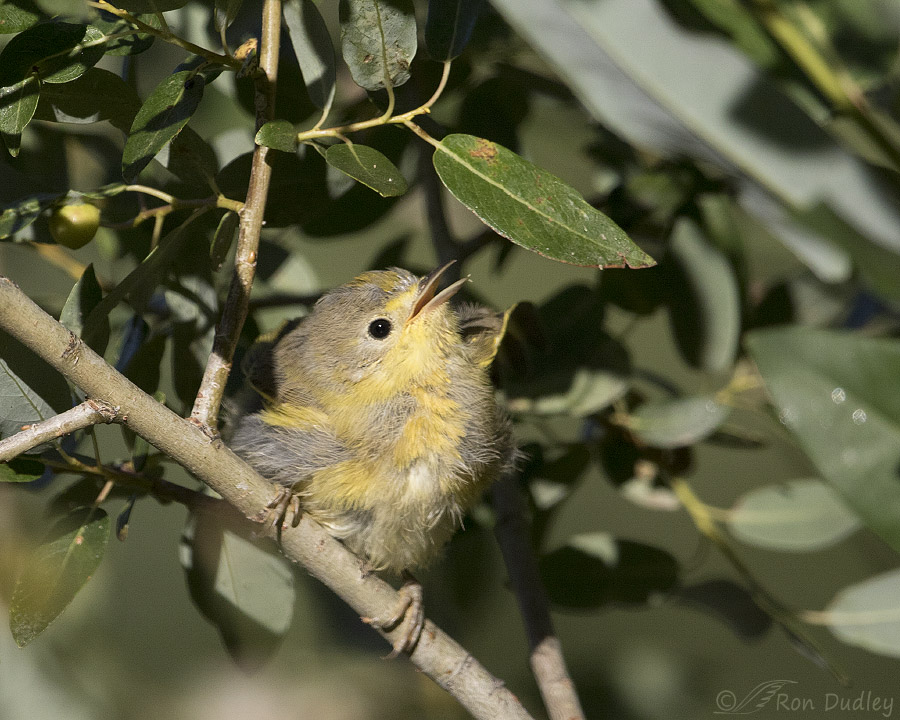
1/4000. f/6.3, ISO 800, Canon 7D Mark II, Canon EF 500mm f/4L IS II USM + EF 1.4 III Extender, not baited, set up or called in
The fledgling saw the parent coming in with food from upper right and immediately began to call but it never knew from which direction she would actually approach or where she would land.
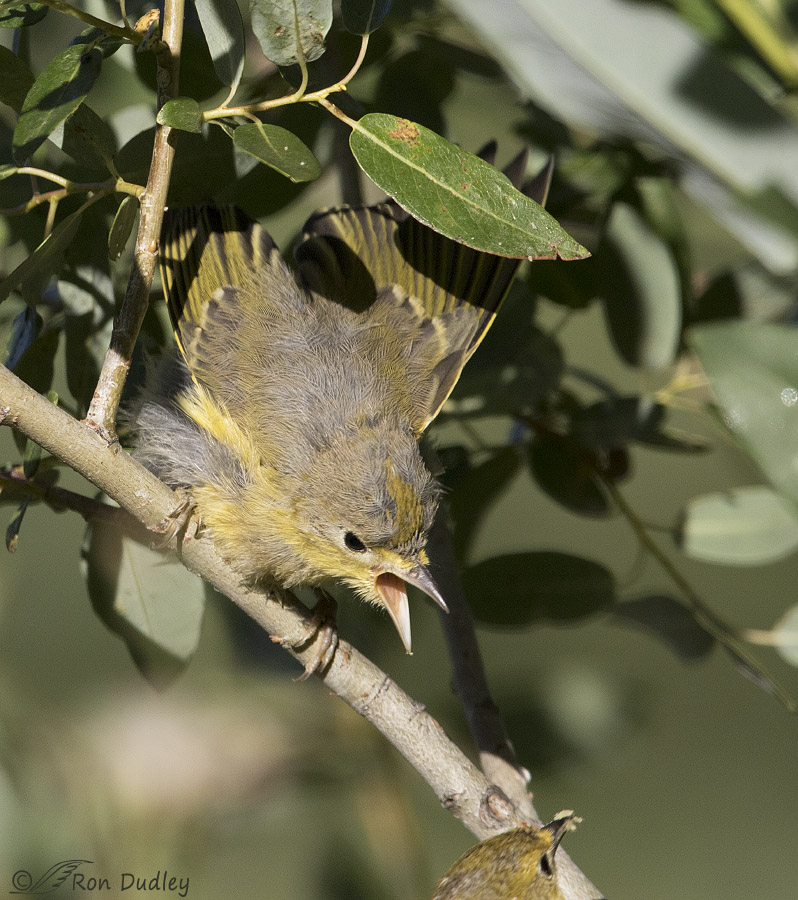
1/2500. f/6.3, ISO 800, Canon 7D Mark II, Canon EF 500mm f/4L IS II USM + EF 1.4 III Extender, not baited, set up or called in
This time she came in from below – here we can just see her head entering the frame.
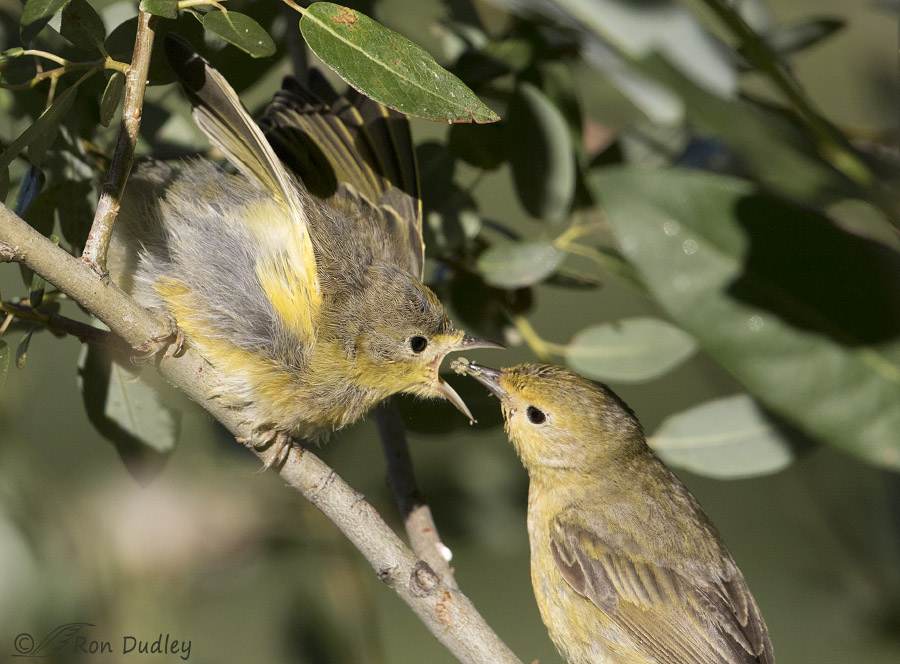
1/2500. f/6.3, ISO 800, Canon 7D Mark II, Canon EF 500mm f/4L IS II USM + EF 1.4 III Extender, not baited, set up or called in
By now the youngster was in full begging mode as the parent brought in the meal. When I looked carefully at a big crop of this image it appeared to me that the adult had aphids in her beak.
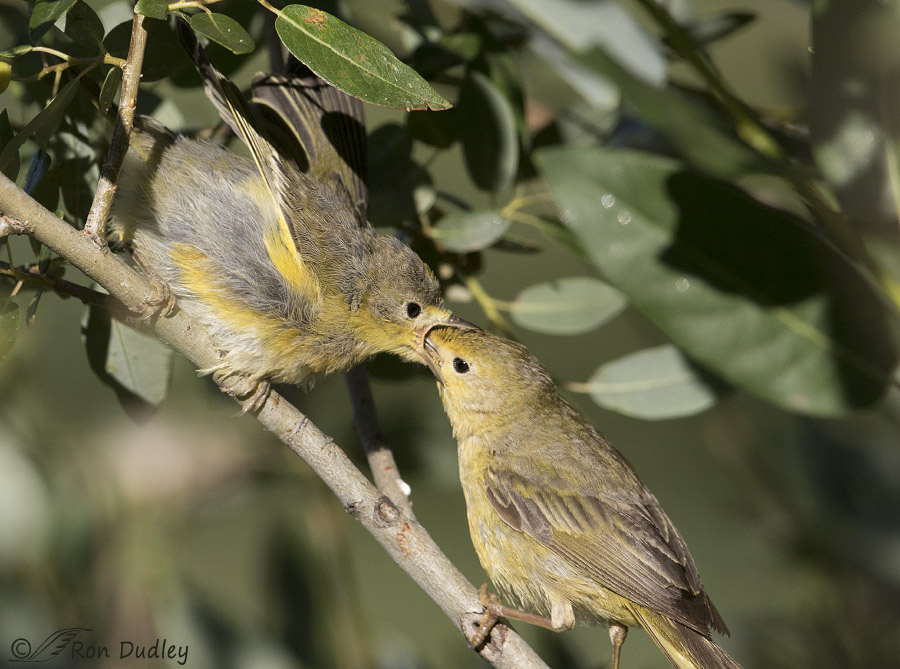
1/3200. f/6.3, ISO 800, Canon 7D Mark II, Canon EF 500mm f/4L IS II USM + EF 1.4 III Extender, not baited, set up or called in
And she almost stuffed those aphids clear down to the toes of the fledgling.
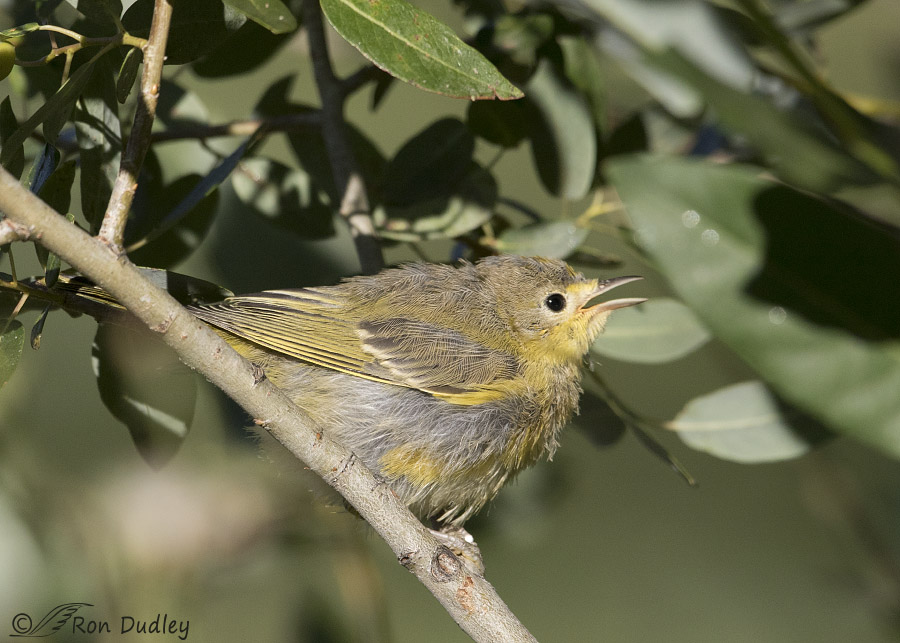
1/3200. f/6.3, ISO 800, Canon 7D Mark II, Canon EF 500mm f/4L IS II USM + EF 1.4 III Extender, not baited, set up or called in
The adult flew off almost immediately but that didn’t stop the youngster from calling for more food. When that didn’t work…
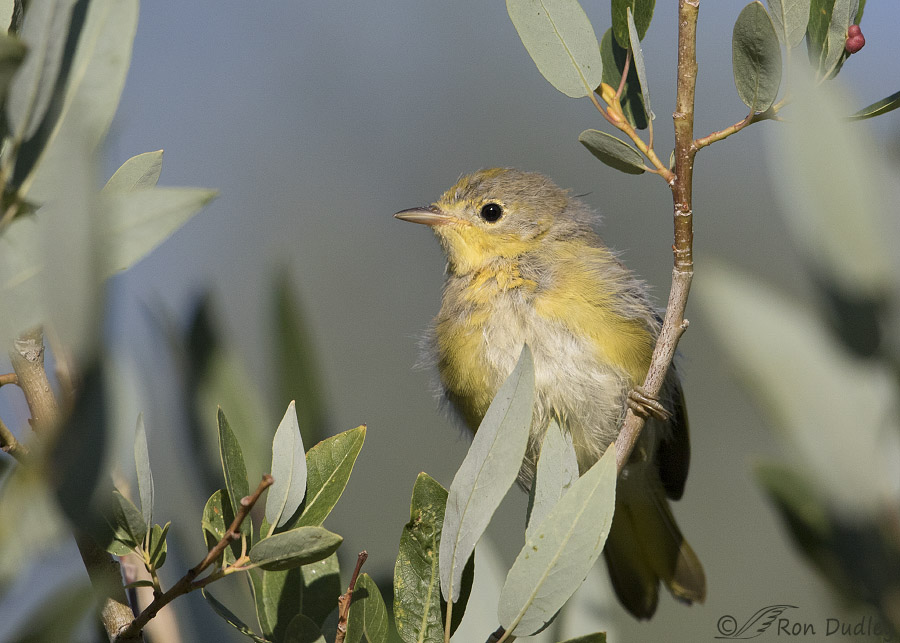
1/6400. f/6.3, ISO 800, Canon 7D Mark II, Canon EF 500mm f/4L IS II USM + EF 1.4 III Extender, not baited, set up or called in
it flew a very short distance (perhaps two feet) to another perch and kept a lookout for another incoming meal.
This encounter was a double-first for me – my first time photographing a fledgling Yellow Warbler and my first time seeing a warbler of any species feed its offspring. It was great fun.
Ron


We don’t have Yellow Wablers on the east coast. The first photo of this precious baby has got to be the cutest any bird. ever saw. I have many babies and Moms in my yard and I love watching them line up waiting their turn. They are all cute but none comes close to this little fluffy bird, I go back and look at him/her a few times a day. Your photo is perfect. He/she has a little smile on his/her face that makes me smile. I am so glad you got this second in time photo and that it passed your inspection so we can enjoy it. Thank you!
First time I saw a warbler feeding young, it was a Brown-headed Cowbird chick being fed by a Wilson’s Warbler. Tough to watch, knowing what had gone before. These are terrific photos and great fun!
Brilliant series.
Yet again my anthromorphic self is simultaneously awed by the parenting tasks – and sorry for the poor tired parents.
I have the same thoughts, EC. I saw a kingbird feeding fledglings today that looked completely frazzled by the job of keeping those chicks fed and happy.
I find myself wondering whether there are any ‘bad’ bird parents. There are certainly some on our species and as a child a cat we had simply walked away from her kittens (at birth) but does anyone know of birds who decided that parenting was simply not for them?
EC, there are bad bird parents. My first experience with seeing a bird nest was with a Mourning Dove who built a nest in the hanging fern right by my front door. She sat on the eggs faithfully, but when they hatched, she went and sat in a nearby tree and just watched her babies die. All these years later it’s still a heart-rending memory.
I would guess that the quality of parents is on the same kind of bell curve as humans in that there are some that are REALLY good (at one end of the bell) and some that are REALLY bad(like the dove Ron witnessed). In the middle are all the rest of the parents that range from OK to pretty good. For example, my mother was on the almost really bad part of the scale, mostly on a sea turtle model (have a nice life–see ‘ya!). Every now and again, she’d dip down into a guppy model, threatening to eat her young (me). Her younger sister was at the near excellent range, teetering on the brink of a helicopter model. I certainly learned self-reliance compared to my cousins who didn’t. They learned different things, like always having a safety net they could always count on being there when they needed it. Which is better? I have NO idea.
A veterinarian/falconer friend of mine tells me that the hormone prolactin induces that stay put/incubation nesting behavior. It does a similar thing in mammals, but in mammals it also stimulates milk production. So it’s possible to have variation in the hormone levels which would drive care for the young. Just GUESSING here, but it makes sense to me. That said, I can ALWAYS be wrong. It happens frequently 🙂
Thank you Susan and Laura. I expected that there were bad bird parents but didn’t know. As for being wrong? That is something that I do on a regular basis. Including (shame on me) sometimes repeating mistakes.
Don’t feel like the Lone Ranger EC. That’s how I ended up in NY. Evidently I forgot that I don’t belong anywhere east of the Mississippi and needed to be reminded. Don’t get me wrong. It’s beautiful there. It’s just that my soul belongs here. I can’t explain that. I shouldn’t make that mistake again but only because I’m running out of time 🙂
These are really nice…the eyes on the birds seem to say it all…the parent looks overworked while the baby looks happy as can be…or maybe I’m just projecting…?
If you’re projecting I’d say you’re doing it accurately, SkyKing. Thanks.
Oh, what a fun series! Congratulations on this “first” for you! The fledgling is so cute, although by now, I think the parent might be using another term. 😉 I love the image of stuffing the aphids down to the toes of the youngster. I also wish they were in our yard — and so do our roses!
Wouldn’t that be great, Marty – having these lovely little birds flitting around our yards and at the same time keeping those damned aphids under control!
Beautiful photos, the light and colors are lovely. Adorable little birds. I always feel they have so much to learn in so little time.
They do, April. School is accelerated for young birds at this stage.
Holy Smokes they are just so cute. Great pictures, they are keepers. Thank you once again.
Thank you, Trudy.
Great Natural History here Ron. Fantastic that you got all this without vegetation in the way!
Sounds like you know the drill, Frank. Obstructions in front of warblers are the norm rather than the exception.
Truly excellent photos! It is evident you’ve spent a lot of time capturing this amazing sequence.
Yeah, I was there with these birds for quite a while, Marian. I deleted most of my shots of them but there are a few I like a lot.
Now there’s a “PEEP” I could really like!!! Forget those awful marshmallow things. A PEEP is the first thing I thought of when I saw image number one. Love the composition in the last shot…very artistic….
Patty, there’s another thing we share. I despise marshmallow ANYTHING and Peeps are at the top of that list. Appreciate your feedback about the composition.
This is a wonderful series! Getting a shot of the parent stuffing the food down the youngster’s throat is a very special thing. Congratulations!
I thought it was pretty special too, Susan – despite the lack of a catch light in several of the shots.
What a glorious series, Ron! I think my favorite thing in life is to watch birds parenting their young and watching the kids grow into fledgling birds, taking their place if the world. And I’m not real fussy about the species, either. It gives me BIG joy! I’m so thankful that you bring this joy to me (almost) every morning! Just want you to know that!
I appreciate that very nice feedback about my blog, Laura. Thank you.
What a wonderful behavioral series Ron!
Charlotte
Thanks, Charlotte.
Wonderful sequence!
Thank you, Nancy.
Great shots and great post Ron, many thanks!
Thanks, Dick.
Another awesome series! Thank you.
Thanks, Elmer.
Wonderful way to start the day! Thanks, Ron!
I’m glad you enjoyed them, Diane.
Terrific sequence.
Thanks, David.
If anyone wants to see some truly wonderful warbler photos check out this link to David’s site. I didn’t even know there was such a thing as a Brewster’s Warbler in North America.
https://davidlsparks.squarespace.com/various-sundry-blog/r5c8gxhy7gff8f356a7alksk6wd967
My husband is from Maine…so like a true Mainiac, calls them “wobblers”….
Great series, Ron! 🙂 Getting them in the leaves is quite a challenge! Thinking of talons and Laura mentioning the GHO yesterday – since the young have to “learn” to perch are their legs different?
Good question, Judy. I’m not sure…